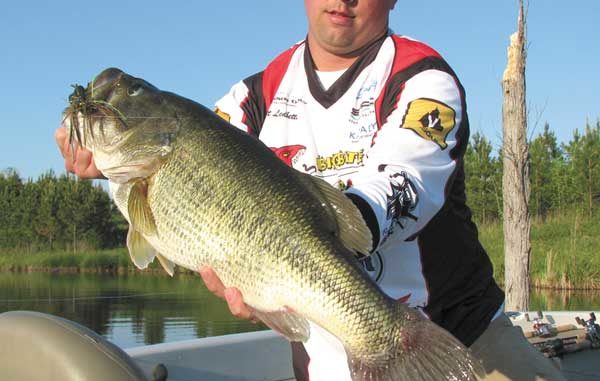
A lot of fishermen never think of taking their boat out in December. They’re deer hunting or thinking about Christmas, and they don’t realize how good the fishing can really be. Unless we get an early blast of cold weather, December in North Carolina is usually just an extension of November – which can be an extremely good month. In fact, as long as the surface water temperature is in the 50s, there will still be bass that will chase a bait pretty good. If it gets down in the mid 40s, it can be pretty tough. So everything really depends on the weather.
One way I can describe bass fishing in December is like this: the fish will either be real shallow or real deep — depending on how cold it’s gotten.
If the weather is mild, you’re looking at a true extension of November, with fish back in creeks, either all the way back or holding on channel bends and drops. You catch those fish on a crankbait. If the weather is a little on the cold side — if the first blast of winter weather has arrived — they’ll be out on the main-lake area in deep water.
Either way, December is usually a three-bait month. You’ll catch fish with a crankbait, a jig or a jigging spoon. Fish get off of soft-plastic baits as the water cools. You might be able to catch one or two on a spinnerbait, but mostly, it’ll be the three I mentioned.
The most stable patterns on North Carolina lakes — with the exception of High Rock and other lakes that tend to get real dingy — is fishing adjacent to a channel in 20 to 25 or 30 feet of water. Bass are going to be close to a channel; they’ll never get far from one, whether it’s the mouth of a creek channel where it dumps into the main lake, a ditch that comes off the bank in the main lake, or the main river channel. The one exception is maybe when you can be sitting in 25 feet of water and make a short cast to the bank; a bluff bank like that can be real good, but fish can change depths so easily that they’re sometimes hard to catch.
There are a lot of fish that move into creeks and stay there — and those fish are shallow. The only problem is those fish get caught out pretty quick. There’ll be a lot more fish out in the deep water, and they’ll get bunched up.
If you find fish in range of a deep-diving crankbait like a Rapala DT-16 or DT-20, you should be fishing some kind of shad pattern or color. Solid white or solid bone can be real good. A jig is also a really good bait when you’ve got fish that are still at a reasonable depth. When they get deeper, there’s nothing like a spoon.
For jigging, there’s the old reliable 1 1/2-ounce Hopkins spoon. I also like a Swedish Pimple in No. 9 size. It’s a real shiny spoon that’s thinner than a Hopkins. I have used hooks with a feather or bucktail tied in, but most of the time I don’t.
And although some fishermen don’t like to use a spoon with a treble hook, I won’t fish without a VMC Sure Set hook on a spoon.
I want to fish a 7- or 7 1/2-foot American RodSmith rod in all jigging spoon situations. It makes for a better hookset. Most of the time, you’re looking for bass that are within 4 feet of the bottom. If they get off the bottom much more than that, they get tough to catch.
I look for jigging-spoon fish at underwater structure. A perfect example is Buggs Island Lake.
When I go there in December, I fish a lot of long points that drop off real quick into a channel. The closer the fish are to the channel, the better they’re going to bite, and there’s going to be a lot of them.
When I’m fishing a jig or a jigging spoon, I like to fish 17- to 20-pound line. You can go with 14, but I like the heavier line a little bit. I’m fishing Sufix Pro-Mix and Sufix Titanium a lot now. Pro-Mix has a little more stretch than I like, but it’s a little more abrasion resistant than Titanium. Either one of them is a real good line to use jigging.
A new bait Rapala is supposed to debut this month may enter into your deepwater patterns. The Crackin’ Rap is a big lipless bait that reminds me of the old “one-knocker” Hot Spot baits that were popular in the 1980s. They’re a little bit smaller but heavier than the old Spots.
What’s good about them is that you can fish them vertically like a jigging spoon, but you also can cast them out and hop them back. You can do that with a jigging spoon, but a Crackin’ Rap is better. And like a jigging spoon, you need to fish them with a 7- or 7 1/2-foot rod.
David Fritts is a 51-year-old pro bass fisherman from Lexington. He won the 1993 Bassmasters Classic champion, the 1997 FLW Tour Championship and the 1994 Bass Angler of the Year title. He is sponsored by Ranger boats, Evinrude outboards, Rapala, Zoom, VMC, American RodSmiths, Bass Pro Shops and Chevrolet.




Be the first to comment